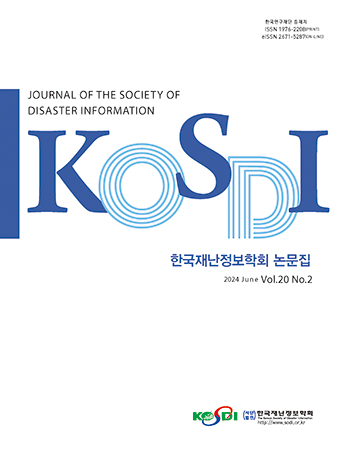Original Article
Abstract
References
Information
Purpose: The purpose of this study is to develop IoT multi-fire detectors combined smoke/carbon monoxide/heat and wireless IoT communication and to confirm the detect performance by smoke generator fire test and cotton wicks fire test. Method: The IoT multi-fire detector combined smoke and CO and combined smoke and heat were experimented the detect performance by smoke generator test and fire test of cotton wicks. And the case of fire alarm was checked. Result: The IoT multi-fire detector combined smoke and CO rung the alarm at the fire test of cotton wicks, did not ring the alarm at the smoke generator test. In comparison, the IoT multi-fire detector combined smoke and heat did not ring the alarm both at the smoke generator test and the fire test of cotton wicks. Conclusion: The IoT multi- fire detector combined smoke and CO detected the only smoke including the carbon monoxide and the IoT multi-fire detector combined smoke and heat did not ring the alarm for lack of heat. As a result, when the developed IoT multi-fire detector was detected the signal more than the set point, the fire alarm was sounded through cotton wicks fire test and smoke generator.
연구목적: 연기/CO/열 복합형 화재감지기와 무선 IoT통신을 결합한 IoT 멀티화재감지기를 개발하고 화재감지 실험을 통하여 연기/CO/열 복합형 IoT 멀티화재감지기의 화재감지성능을 확인하는 것을 목적으로 한다. 연구방법: 연기/CO 복합형 과 연기/열 복합형의 IoT 멀티화재감지기를 연기발생기와 면심지 연소를 통하여 화재감지성능을 실험하였으며, 화제 신호를 발하는 기준을 확인하였다. 연구결과: 연기/CO 복합형 IoT 멀티 화재감지기는 면심지 연소 실험에서 화재를 감지하였으나 연기발생기 실험에서는 화재를 감지하지 않았다. 반면 연기/열 복합형 IoT 멀티 화재감지기는 두 실험 모두 화재를 감지하지 않았다. 결론: 연기/CO 복합형 IoT 멀티화재감지기는 CO가 포함된 연기만을 감지하였으며, 연기/열 복합형 IoT 멀티 화재감지기는 열의 부족에 의해 화재를 잠지하지 않았다. 이와 같은 결과로 개발된 IoT 멀티 화재감지기는 면심지 연소 실험과 연기발생기 실험을 통해 2가지 센서의 기준값 이상 신호를 검출하여야 화재 신호를 발한다는 것을 확인하였다.
- Cha, J.H. (2016). "A study on improving the standard related to fire alarm malfunction in security system." Asia- pacific Journal of Multimedia Services Convergent with Art, Humanities, and Sociology, Vol. 6, No. 12, pp. 675-682.
- Choi, K.C. (2015). Technical recommendation to reduce false fire alarm of automatic fire detection system. Dongwon University, KFI, KR.
- Kim, S.K., Yuk, H.D., Yang, S.H., Jee, S.W., Lee, C.H. (2009). "A study on the problem of tester for the field inspection of the photoelectric smoke detector." Korean Institute of Fire Science & Engineering, Vol. 23, No. 4, pp. 137-144.
- Nahid, C., Dewan, R.M., AZM, E.C. (2019). "Computer vision and smoke sensor based fire detection system." 1st International Conference on Advances in Science, Engineering and Robotics Technology 2019, Bangladesh, Dhaka, pp.1-5.
- Park, I.D., Kim, C. (2016). "A study on railway vehicles fire detection using HMI touch screen." Journal of the Korean Institute of IIIuminating and Electrical Installation Engineers, Vol. 30, No. 1, pp. 38-43. 10.5207/JIEIE.2016.30.1.038
- Ryu, H. (2014). "Analysis on activation characteristic of heat detectors in a compartment fire." Journal of The Korean Society of Disaster Information, Vol. 10, No. 4, pp. 598-608. 10.15683/kosdi.2014.10.4.598
- Ryu, H., Kim, D. (2015). "Study on the operation characteristics of heat detectors through fire and wind tunnel experiment." Journal of The Korean Society of Disaster Information, Vol. 11, No. 2, pp. 203-209. 10.15683/kosdi.2015.11.2.203
- Ryu, H.C. (2014). "Analysis for detector response time by installation location of heat detector." Journal of the Korean Society of Hazard Mitigation, Vol. 14, No. 5, pp. 267-274. 10.9798/KOSHAM.2014.14.5.267
- Seo, B.K., Nam, S.G. (2016). "Study of the improvement of false fire alarms in analog photoelectric type smoke detectors." Korean Institute of Fire Science & Engineering, Vol. 30, No. 5, pp. 108-115. 10.7731/KIFSE.2016.30.5.108
- Publisher :The Korean Society of Disaster Information
- Publisher(Ko) :한국재난정보학회
- Journal Title :Journal of the Society of Disaster Information
- Journal Title(Ko) :한국재난정보학회논문집
- Volume : 17
- No :2
- Pages :236-244
- DOI :https://doi.org/10.15683/kosdi.2021.6.30.236




 Journal of the Society of Disaster Information
Journal of the Society of Disaster Information







